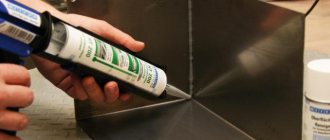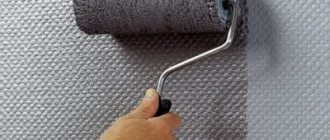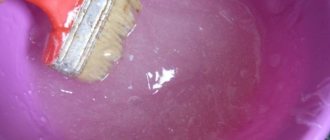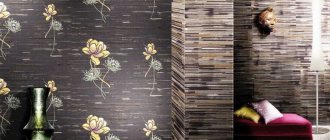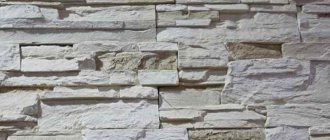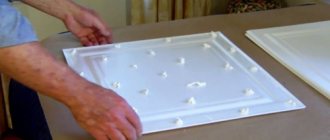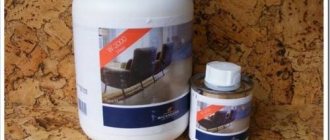Glass wallpaper
This is a fiberglass material, made on machines, intended for wall decoration. Often used for painting.
Woven building material, during weaving of which designs are realized. There are fewer forms than paper counterparts, the pattern is poorly defined, but due to practicality and the possibility of re-dyeing, the shortcomings are almost invisible.
Drawings are divided according to roughness into fine, medium, and coarse texture. The “matting” design is considered common. The name was given from a woven material with a similar name.
Walls with glass wallpaper
Among the designs you can find Christmas trees, diamonds, and a checkerboard pattern.
Advantages, disadvantages
Pros:
- The material is environmentally friendly. Does not emit any harmful substances into the surrounding air.
- Due to the structure of the fiber, it is vapor permeable. Does not allow moisture to accumulate and prevents the formation of fungus.
- Fiberglass wallpaper is abrasion resistant.
- Subject to production technology, they can withstand repainting up to 20 times. The service life reaches 30 years.
- Fire resistant. In case of fire, they will not burn or release toxic substances.
- Moisture resistant. Resistant to direct water ingress.
- Immune to ultraviolet rays.
- Antistatic, repels dust from the surface.
- Not demanding in care. For preventative cleaning, it is enough to carry out wet cleaning.
Minuses:
- Compared to paper counterparts, they are much more expensive.
- Gluing requires expensive adhesives.
- Dismantling can take a long time, but the high-quality glued canvas holds up very well.
- When working with fiberglass, precautions must be taken. Wear protective equipment: gloves, respirator, goggles, protective suit.
There is no need to neglect safety rules. Without using protective equipment, you can pay a lot.
Look at the technical specifications
The density of the material must be taken into account. It is necessary to proceed from where the glass wallpaper will be glued. If the canvas is for the ceiling, the density is 25-30 g/m2, for wall decoration - at least 150 g/m2.
When producing fiberglass wallpaper, the manufacturer indicates the type of material on the packaging. The first grade canvas has high quality, the second grade can go on sale with minor defects. Sometimes defects are reflected not in the visible part of the product, but, for example, in the quality of the fiber. The product will cost slightly less, but will most likely last less time.
Manufacturers
When choosing, consider reviews of manufacturers.
Classification
It goes without saying that most stores and construction outlets offer several different types of similar products. Let's take a closer look at what their features are, as well as their differences.
On a note! The Kleo brand has become one of the most popular in Russia and other CIS countries. To a large extent, it owes its wide distribution, as well as high popularity among buyers due to the combination of consistently high quality and, at the same time, affordable price.
Types of universal glue
In cases where some of the special types of glue for fiberglass wallpaper are not available, or if there is simply no need for them, you can purchase universal glue. Here are the most common types of universal adhesives:
- For all types of wallpaper. The technical characteristics of this composition are good enough to firmly and reliably adhere most of the modern coatings. In this case, a reservation should be made: the working surface of the wall must be prepared for gluing and covered with a primer.
- In addition, there are adhesive compositions that are designed for installing wallpaper such as non-woven or vinyl, which belong to the category of so-called “heavy” canvases. Despite the fact that this composition was not originally developed for gluing glass wallpaper, it can also be safely used, since it has proven itself well when installing fairly heavy wallpaper coverings. That is why gluing will be reliable, and the service life of the canvases will be very long.
Specialized types of compounds
As a rule, most manufacturers of fiberglass wallpaper also make special glue. At the same time, a variety of product names are offered by independent manufacturers who specialize specifically in this type of product.
Attention! One of the most acceptable options is to purchase glue that was produced by the same company that produces the fiberglass wallpaper itself. By the way, some manufacturers offering fiberglass wallpaper do exactly this, selling both at the same time, in one set. This is actually very convenient for potential buyers who no longer need to waste time and look for some alternative options.
As for the special types of fiberglass wallpaper glue themselves, they, in turn, can also be divided into several subtypes. Here they are:
- Special formulations that are prepared by diluting in warm water. This option is one of the most common. This was made possible to a large extent due to the fact that such a dry mixture is supported by its low price, which makes it the most affordable option on the market. It should be noted that we are talking specifically about high-quality adhesive compositions, since, of course, in some stores there are compositions of obscure origin that are not of any acceptable quality.
- Do not forget about such a variety as special types of glue, which are characterized by a high level of frost resistance. This can be an indispensable solution for those people who plan to wallpaper in buildings and premises such as country houses intended exclusively for summer living, as well as cottages, cold verandas and other premises characterized by prolonged exposure to low temperatures, including h. and negative ones.
- In addition to dry types of glue for glass wallpaper, it is necessary to mention ready-made mixtures. It is not necessary to dilute such compositions using water, since they are ready for use. However, when purchasing them, you need to be careful, since for high-quality gluing to guarantee high results, you need to purchase products only with a verified shelf life, which should be, as they say, “with a reserve.” Well, it goes without saying that there is no point in buying options at a bargain price, because... they may simply turn out to be of poor quality, or even completely fake.
You should know! Among the compositions that many professional experts recommend in their reviews, brands of fiberglass wallpaper adhesive such as Bostic and Oscar are often noted. Their technical characteristics are very high, and they themselves meet extremely high requirements and standards. However, at the same time, their higher price must be taken into account. In a way, the cost of such brands can be called, to a certain extent, a disadvantage, since the cost makes them inaccessible to some categories of buyers.
Density indicator, choice of glass wallpaper
How to determine the quality of wallpaper? This is done by touch. But sometimes, when gluing to a surface, the canvas may lose density. To obtain a three-dimensional pattern, the fibers are fluffed, and after the glue dries on the glued strips, the pattern is compressed.
Manufacturers are increasing the density of the material. The fibers are impregnated with starch. When the starch comes into contact with the adhesive solution, the fibers become loose.
Check the density indicators indicated on the product packaging. Standard values are 145 g/m2.
There is a simple way to determine density: the higher the weight, the denser the material.
When choosing paper wallpaper, the guideline is its decorative qualities; when buying fiberglass analogues, you should not pay attention to them.
Glass wallpaper in the interior
You can determine the quality of a product by its appearance. For example, it is worth looking at the tightness of the threads.
Mode of application
The process of gluing glass wallpaper is, in principle, very similar to the traditional one. But it has characteristic differences.
Fiberglass wallpaper is undemanding regarding the ideal flatness of the surface on which it will be glued. It is enough to remove large defects: cracks, holes, depressions. There is no need to putty the surface.
For better bonding and protection from fungi and dampness, it is recommended to prime the surface with glass wallpaper adhesive. But this will need to be done a day before the main process, so that the primer has time to dry completely.
The material of the surface to be pasted does not matter, but there is a not recommended option - plaster. Due to the unevenness of the layer, it is often not saturated with glue enough to ensure high-quality adhesion.
Glue for glass wallpaper is applied ONLY to the surface to be treated: wall, ceiling, etc. Therefore, glass wallpaper is rolled up with the front side inward, and there is a colored stripe on the back side.
They are glued end-to-end, and it can be either vertical or horizontal.
From the moment the glue is applied until it sets, approximately 20 minutes pass. This time can be used to adjust the position of the sheet and ensure a tight fit.
It must be borne in mind that glass wallpaper may have sharp fragments of glass fibers on its front surface. Therefore, it is recommended to protect the skin of your hands with gloves while working. Safety precautions also require respiratory protection with a mask or respirator, and hair with a cloth. The joints of the sheets are processed with plastic spatulas.
In order to calculate the required amount of glue, you need to measure the area of the surface to be glued and multiply it by 200-300. The resulting figure will be the required weight (in grams) of the finished glue. During the priming process, 50 to 100 grams of glue are consumed per square meter of surface.
Glue selection
It’s worth mentioning right away that ordinary glue is not suitable for working with glass wallpaper. Compounds suitable only for fiberglass are required.
The canvas weighs a lot, the glue must withstand a lot of weight.
If you replace the adhesive mixture with other analogues, bubbles may appear under the canvas, which will lead to peeling.
To avoid making a mistake with your choice, read the conditions of use on the packaging. The manufacturer indicates that this composition is intended for gluing fiberglass products.
Glue
The cost cannot be called budgetary, but the wrong mixture can lead to unpleasant consequences. It is better if the glass wallpaper and glue were produced by the same manufacturer.
Features of adhesive for roll coating with glass fibers
Fiberglass wallpaper is a wall covering made from special glass fibers. They are quite heavy, but at the same time reliable and durable. They can be used to decorate walls in any room, even in the kitchen and bathroom. The characteristics of the coating are such that it is not afraid of humidity and contrasting temperatures. To choose the right glue, you need to remember that it must adhere well and reliably to the surface and material.
The usual composition for gluing glass wallpaper consists of starch, but not ordinary, but modified, it increases the adhesion of the mixture. The mixture for glass wallpaper also includes an antiseptic (it fights mold and parasites) and fungicides. The high-quality composition contains special chemical impurities that make it swell very quickly and dry no less quickly when gluing. Some chemicals fight fungi. To be honest, the composition is almost the same, it is always starch and impurities, however, more expensive mixtures cook faster (swell in water) and dry out faster.
Types of mixtures for roll coatings with glass fibers and their characteristics
For durable and reliable gluing of walls with glass wallpaper, several types of adhesives are suitable. Dispersion adhesives are considered the best among professionals; they are specially designed for such coatings. They are distinguished by a dense structure and increased strength, dry quickly and glue very reliably. The only negative is that it will be difficult to peel off the coating; you will have to use solvent compounds.
Any thick, heavy composition intended for gluing textured, glass and textile coatings is also suitable. All of them are made on the basis of regular PVA with various additives. Optimist paste is an excellent example of a viscous product. Its consumption cannot be called economical, but the clutch is very reliable.
In some cases, if it is not possible to purchase a special mixture, or when a combined pasting is planned, it makes sense to simply buy a high-quality universal composition. In such a situation, you need to pay attention to universal glue with fungicides and antiseptics; with their help you can avoid mold and mildew, for example, “Nortex” (made from starch). A paste for vinyl and textile coverings, reinforced with synthetic resins and resistant to cement and lime, is also quite suitable.
A good example of such compositions are the mixtures “Bustilat”, “Moment”, “Cleo Ultra”, “Pufas”, “Optimist”. The Finnish “SAMTEX” is another successful example; it consists of modified starch and a PVA suspension. It is designed specifically to work with any heavy coatings. Suitable for any walls, but ideal for it would be wooden, plaster or concrete walls primed with the same glue. The composition “FINTEX” has also proven itself to be excellent; it is also based on PVA, but also has excellent disinfectant properties.
The mixtures “Bustilat”, “Moment”, “KMC-Profit”, “Pufas”, “Nortex”, “Kelid” work well. The Finnish “SAMTEX” is another successful example; it consists of modified starch and a PVA suspension. It is designed specifically for any heavy coatings. Ideal for it would be wooden, plaster or concrete walls primed with the same glue. The composition “FINTEX” has also proven itself; it is also based on PVA, but also has disinfecting properties. Cleo Ultra glue is sold in powder; a mixture made from it perfectly disinfects surfaces. Quelid mixtures, produced in France, have also proven themselves well among professional repairmen. The average glue consumption is 300-400 grams of finished mixture per square meter of coating. Choosing an adhesive for glass wallpaper is not easy; remember, the one that works best is the one that is designed specifically for this type of coating. It makes sense to use universal displacements only in extreme cases.
Surface preparation
Regardless of the type of surface used for gluing, each one needs preparation. Incorrect work progress may affect the service life of the applied product.
Wall preparation consists of several stages:
- The old finish is being removed. If the surface was covered with paper wallpaper, it is recommended to spray it with a spray bottle and remove the paper from the walls with a wide spatula. If there are vinyl analogs on the walls, remove the top layer of vinyl and follow the same steps as with paper wallpaper.
- All irregularities are removed. It is necessary to knock down the bulges and cover up the cracks.
- Using a primer, the adhesive properties of the surface are improved.
- A layer of putty is applied. Drying time is at least 12 hours.
- The dried surface is sanded with a grater with an abrasive mesh.
Sanding
- The walls are being re-primed.
It’s good if the surface is covered with plasterboard, then all that remains is to cover the seam joints.
Dyeing process
Since wallpaper “breathes,” it is important to choose the appropriate paint that matches this parameter. This is what water-emulsion and water-dispersion compositions are. The best option would be a special paint made exclusively for glass wallpaper.
Painting is carried out in several successive stages:
- Using a roller, apply a thin layer of primer to the dried glass wallpaper. You need two coats with breaks to dry.
- Paint is applied to the dried primer. Here you also need to do two layers with breaks for drying. Coloring is no different from usual, so there should be no problems.
We do not recommend neglecting the primer after pasting with glass wallpaper. With it, the paint layer will not be so absorbed by the trellises, and adhesion will increase significantly. Here's everything you need to know to ensure the best quality wrap. The result is a beautiful, practical, reliable and durable coating. It can be washed and is antistatic, so its appearance will remain for many years.
How to dilute glue
Before preparing the adhesive mass, read the instructions on the product packaging. Each manufacturer writes their own methods for preparing glue; the process is similar in action. Proportions vary.
- Pour water into a previously prepared container.
- Stirring slowly, add the dry mixture. To prevent lumps from forming, glue is poured continuously, in a small stream.
- Leave the mixture for 10 minutes to mature. To determine readiness, stir the glue - it should resemble jelly.
- Dilute with water, add dry mixture to desired consistency.
For inexperienced builders, the manufacturer has provided two scenarios:
- Liquid glue for glass wallpaper.
- Products with an applied layer of glue. Before gluing, wet the canvas with water.
Glue for glass wallpaper: consumption per 1m2
The consumption of finished glue is almost the same for all manufacturers and is 200-300 g per m² of surface for gluing and 100-125 g per m² for priming. It is impossible to determine this parameter more precisely, since it depends on some aspects that cannot be measured with mathematical certainty. Among them:
- absorbent properties of walls;
- quality of preliminary surface preparation;
- thickness of the glue applied.
Advice
You shouldn’t skimp and add water so that there is enough glue for more. On the other hand, if work lasts more than an hour, a natural loss of moisture occurs and the mixture thickens. In this case, it is necessary to add liquid.
If we consider dry mixtures, there is a difference. Although the finished glue consumption will be the same, its preparation requires a different amount of powder.
Consider the amount required for 10 liters of water:
- Oscar Premium - 400 g;
- Kleo Ultra - 650 g;
- "Quelyd Glass Wallpaper" - 450 g.
It should also be taken into account that for machine application, 10% more water is added.
How to glue glass wallpaper
If we compare glass wallpaper with paper counterparts, the process is not much different. The main thing is to accurately mark where the canvases will be placed and create high-quality joints.
Pasting process:
- Wear protective clothing, glasses, gloves, and a respirator.
- When wallpapering, close the windows and doors. When there is a draft, the quality of grip decreases.
- Stick to 17-24 degrees indoors.
- Measure each piece separately. The ceiling height varies in different parts of the room.
- It is worth leaving about 10 cm of margin. It will be possible to adjust the canvas exactly to the size of the wall.
Stock
- The strips are cut using scissors. Do not use knives, they will break the fibers.
- The inner part of the strip is marked with a gray or blue line so as not to confuse the front and back sides.
- Pasting starts from the door and window opening, from left to right.
- Mark the surface of the walls to be sure that the canvases are in the correct position.
- Apply adhesive solution to the walls.
- Applying the glass wallpaper to the wall, smooth it with a plastic wing (spatula).
- The excess part is removed with a sharp stationery knife.
- The canvases are joined without overlap.
- To start painting glass wallpaper, you need to wait 1-2 days.
What layer of glue should I apply?
Since glass wallpaper is a heavy finishing material, for its reliable fixation it is necessary to apply a sufficient amount of adhesive mixture. It is applied to the wall, and not to the wallpaper. A prerequisite is to first apply a primer to the wall. Only after the soil has completely dried (no earlier than 8 hours after applying the composition) can you begin gluing.
The glue is applied with a thread paint roller, and its layer on the wall should be about 1-2 mm. When smoothing the wallpaper, part of the adhesive mixture comes through the porous surface of the wallpaper. It doesn't need to be washed off. Using a plastic spatula, spread the released glue evenly over the entire area of the canvas. After drying, it will become colorless and will act as a primer if subsequent painting is planned.
How to properly glue non-woven wallpaper on walls?
Material consumption per 1 sq. m. when covering walls with liquid wallpaper
What kind of glue is needed for vinyl wallpaper?
Useful tips
Helpful Tips:
- Upon completion of work, clean with a damp cloth. Spray water from a spray bottle. Flying particles will settle on the floor, from where they will be removed with a damp cloth.
- You should not ventilate the room earlier than after two days.
- If bubbles are detected, fill the syringe with glue and insert it under the canvas. Smooth the area with a spatula.
- If the joints start to come apart, PVA glue will help.
- Painted glass wallpaper can be wiped with a damp cloth.
Painting
Choosing a brand
Ready-made Oscar glue in a 10 liter container
The most popular brand is Oscar.
This manufacturer produces dry adhesives and primers of good quality, which are in demand in the construction market.
Oscar benefits:
- Environmentally safe, does not harm the health of humans and pets.
- Contains chemical additives that prevent the appearance of fungus and mold even in conditions of high humidity.
- Frost-resistant. Stored at temperatures from -40 °C for more than 3 days, can survive up to 5 freezing/thawing cycles.
- Advantageous in use - 100 grams of dry mixture yields 3 liters of the finished composition.
- Economical - up to 300 grams of prepared glue is used per 1 m² of canvas.
- Easy to prepare. It is diluted in cold water and swells in 10 minutes.
- The ready-to-use composition can be stored in a closed container for 2 months.
- The dry mixture in sealed packaging is easily transported and can be stored for up to 4 years.
As can be seen from the characteristics, we have before us a worthy representative of the adhesive construction family.
The composition is applied directly to the wall or ceiling using a brush or roller. The ability to adjust (adjust the pattern of the canvas) lasts about 20 minutes.
Ready-made dispersion adhesive is sold in packages of 5 and 10 kg and can be used for gluing vinyl wallpaper, as well as heavy textile fabrics.
Preparing the wall
By the way, highly diluted glue can be used as a primer when preparing the surface.
To prepare, pour the dry mixture into a bucket and gradually add water, stirring gently with a mixer. After 10 minutes the glue is ready for use.
